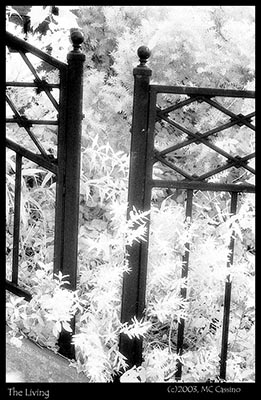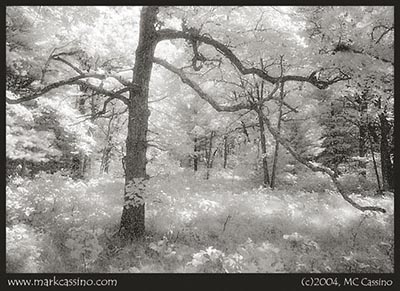 A few weeks ago, while in the local camera shop, I indulged myself and picked up a couple of rolls of Kodak HIE – High Speed Infrared film. This is a wonderful film that is truly unique. I shot both rolls last Friday – preliminary results are not that promising – but working with for the first time in several months made me think a little about some of the characteristics that set this film apart.
A few weeks ago, while in the local camera shop, I indulged myself and picked up a couple of rolls of Kodak HIE – High Speed Infrared film. This is a wonderful film that is truly unique. I shot both rolls last Friday – preliminary results are not that promising – but working with for the first time in several months made me think a little about some of the characteristics that set this film apart.
Of course – there’s the obvious. It’s an infrared film. Not just a near infrared film, like most of the others that competed for this niche – it’s a true infrared film with sensitivity all the way out to 900 nm. This is one of the few films that can be used with a true infrared filter – like a Hoya RM 90 – to produce images purely from invisible light. (That is – light outside of the visible spectrum.)
But the other interesting feature of this film is the lack of an anti-halation layer. The anti-halation layer in film prevents light from passing through the film and then reflecting back into it from the rear. It also prevents the film from ‘light piping’ – that is, acting like an optical fiber cable and transmitting light along the film.
The lack of the anti-halation layer introduced the nice gauzy highlights seen in the film. It also is partially responsible for the handling issues associated with this film.
Here are just a few random and rambling thoughts on Kodak HIE:
• Handling issues: Kodak advises that this film be handled in total darkness. They always put the words total darkness in italics, so you know they mean it. The truth is that this film really does have to be handled in – you guessed it – total darkness.
Some time ago I took a photography class, and it was asserted there that the total darkness requirement was due to the ability of infrared light to penetrated the felt light seal on a 35mm canister. This may well be the case – but I suspect the handling issues really arise out of the lack of the anti-halation layer.
Due to the lack of the anti-halation layer, HIE will “pipe light” – and any light that hits the leader of the film gets pumped back into the film canister, ruining many frames is not the entire roll.
This film is very sensitive to exposure – I’ve tried loading film in a makeshift changing bag consisting of a black T-shirt under a mid weight jacket in the back shaded back area of my car – and have still lost several frames at the start of the roll due to exposure. Try loading a roll in direct sunlight, and it may well be completely ruined.
The light piping effect is not limited to loading the film. I once accidentally flipped the camera to Bulb setting, and managed to get the cable release stuck while taking the photo. The result was a many seconds long exposure that not only blackened the frame I was shooting, but more or less ruined the entire roll as the light ran along the film into both the exposed and unexposed portions of the film.
On the flip side – I’ve never had any problem with fogging when unloading 35mm canisters. Yes – I usually do unload under a jacket or some other sort of makeshift changing bag, but my experience has been that the sensitivity is just not as great. Again – this is probably because the handling issues arise out of the ‘light piping’ effect, and not so much because the IR light is penetrating the film canister.
• Exposure: Exposing infrared is always tricky. The camera meter is sensitive to visible light, not IR. If you are using a filler – like a #25 red filter – you may find that your camera’s meter is more or less sensitive to red light than other colors. In addition, IR light is highly directional – I’ve learned from shooting digital IR that just a 90 degree rotation of the camera can have a big impact on how much IR light hits the sensor. Since you can’t see the IR light – it’s had to predict how this effect will play out.
Personally, I’ve opted for using one camera (a Pentax ME Super) for all my IR work. Through trial and error I’ve been able to get a handle on exposure issues with Kodak HIE. With this camera, and with a #25 red filter, I set the ISO to 100 and am usually in the ball park in terms of exposure.
I also follow Kodak’s advice and bracket widely – 2 stops in both directions. Nine times out of then, the frame shot at ISO 100 is the right one.
• Filters: Without a filter, HIE is more or less like any other B&W film, except for finicky handling issues and lots and lots of grain. I usually use a #25 red filter with this film. A few years ago I experimented with using a Hoya RM 90 with this film, but in comparison shots I could not see a significant difference in the images taken with the #25 red filter, and the RM 90. So I’ve stuck with the red filter – its a lot easier to be able to see through the finder, and the exposure times are a lot shorter.
• Developers: I’ve developed HIE in Rodinal, HC110, D76 (1+1), and D19, all with good results. My current favorite is Rodinal, 1:50, for 15 minutes. (This is 3 minutes longer than the normal recommendation of 12 minutes, but I also agitate only once per minute.) D19 can produce wonderfully crisp high contrast images with HIE – but it’s not a developer that I usually have on hand.
This film is extremely grainy – IMO, a developer like Rodinal that brings out the grain with brilliant clarity adds to the effect.
 ; Storage and Expiration: Unlike many B&W films that can be used years beyond their expiration date with only minor degradation if stored in a freezer or refrigerator, HIE really does lose its sensitivity to infrared light once it goes stale. That said, I’ve used it a few months beyond expiration with no problems. But, a couple of years ago when I inherited several rolls of B&W film that were several years out of date (but stored in a refrigerator) the HIE was the only one that was unusable. The Tri-X, Plus-X, and even Panatomic-X were all fine.
; Storage and Expiration: Unlike many B&W films that can be used years beyond their expiration date with only minor degradation if stored in a freezer or refrigerator, HIE really does lose its sensitivity to infrared light once it goes stale. That said, I’ve used it a few months beyond expiration with no problems. But, a couple of years ago when I inherited several rolls of B&W film that were several years out of date (but stored in a refrigerator) the HIE was the only one that was unusable. The Tri-X, Plus-X, and even Panatomic-X were all fine.
Those are the only hints and tips I can offer about Kodak High Speed Infrared. Unanswered questions remain – like why is it called Kodak HIE and not HSI? And the big question – how long will it remain available?
Sadly, in the last few years many other fine IR films have bit the dust – Konica IR 750 and Ilford SFX to name two. We can only hope that HIE will survive for a while.
 Last week Pam and I headed out to Annapolis, Maryland, to attended the artist’s reception for the Maryland Federation of Art American Landscapes 2006 exhibit. I was happy to see that one of my two pieces in the show – Weedy Sassafras – won an honorable mention.
Last week Pam and I headed out to Annapolis, Maryland, to attended the artist’s reception for the Maryland Federation of Art American Landscapes 2006 exhibit. I was happy to see that one of my two pieces in the show – Weedy Sassafras – won an honorable mention. One thing notable in both Harry Callahan and Marion Warren’s work is how they really push the contrast in their shots – and are not shy about letting the shadows go to full black. Aesthetically, they don’t have a whole lot in common, but they do seem to share a similar approach to printing.
One thing notable in both Harry Callahan and Marion Warren’s work is how they really push the contrast in their shots – and are not shy about letting the shadows go to full black. Aesthetically, they don’t have a whole lot in common, but they do seem to share a similar approach to printing. 






 A few weeks ago, while in the local camera shop, I indulged myself and picked up a couple of rolls of Kodak HIE – High Speed Infrared film. This is a wonderful film that is truly unique. I shot both rolls last Friday – preliminary results are not that promising – but working with for the first time in several months made me think a little about some of the characteristics that set this film apart.
A few weeks ago, while in the local camera shop, I indulged myself and picked up a couple of rolls of Kodak HIE – High Speed Infrared film. This is a wonderful film that is truly unique. I shot both rolls last Friday – preliminary results are not that promising – but working with for the first time in several months made me think a little about some of the characteristics that set this film apart. ; Storage and Expiration: Unlike many B&W films that can be used years beyond their expiration date with only minor degradation if stored in a freezer or refrigerator, HIE really does lose its sensitivity to infrared light once it goes stale. That said, I’ve used it a few months beyond expiration with no problems. But, a couple of years ago when I inherited several rolls of B&W film that were several years out of date (but stored in a refrigerator) the HIE was the only one that was unusable. The Tri-X, Plus-X, and even Panatomic-X were all fine.
; Storage and Expiration: Unlike many B&W films that can be used years beyond their expiration date with only minor degradation if stored in a freezer or refrigerator, HIE really does lose its sensitivity to infrared light once it goes stale. That said, I’ve used it a few months beyond expiration with no problems. But, a couple of years ago when I inherited several rolls of B&W film that were several years out of date (but stored in a refrigerator) the HIE was the only one that was unusable. The Tri-X, Plus-X, and even Panatomic-X were all fine.



































